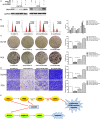Nonconserved miR-608 suppresses prostate cancer progression through RAC2/PAK4/LIMK1 and BCL2L1/caspase-3 pathways by targeting the 3'-UTRs of RAC2/BCL2L1 and the coding region of PAK4
- PMID: 31389670
- PMCID: PMC6746107
- DOI: 10.1002/cam4.2455
Nonconserved miR-608 suppresses prostate cancer progression through RAC2/PAK4/LIMK1 and BCL2L1/caspase-3 pathways by targeting the 3'-UTRs of RAC2/BCL2L1 and the coding region of PAK4
Abstract
The aim of this study is to investigate the functions and mechanisms of miR-608 in prostate cancer (PCa). CISH and qRT-PCR analysis demonstrated that miR-608 was low expressed in PCa tissues and cells, which was partly attributed to the methylation of CpG island adjacent to the transcription start site (TSS) of miR-608 gene. Intracellular miR-608 overexpression inhibited in vivo PCa tumor growth, and suppressed PCa cell proliferation, G2/M transition, and migration in vitro, which was independent of EMT-associated mechanisms. Then RAC2, a GTPase previously deemed hematopoiesis-specific but now discovered to exist and play important roles in PCa, was verified by western blot and dual-luciferase reporter assays to mediate the effects of miR-608 through RAC2/PAK4/LIMK1/cofilin pathway. MiR-608 also promoted the apoptosis of PCa cells through BCL2L1/caspase-3 pathway by targeting the 3'-UTR of BCL2L1. Moreover, PAK4, the downstream effector of RAC2, was found to be targeted by miR-608 at the mRNA coding sequence (CDS) instead of the canonical 3'-UTR. Knocking down RAC2, PAK4, or BCL2L1 with siRNAs reproduced the antiproliferative, mitosis-obstructive, antimigratory and proapoptotic effects of miR-608 in PCa cells, which could be attenuated by downregulating miR-608. In conclusion, miR-608 suppresses PCa progression, and its activation provides a new therapeutic option for PCa.
Keywords: BCL2L1; G2/M arrest; RAC2; PAK4; microRNA-608; prostate cancer.
© 2019 The Authors. Cancer Medicine published by John Wiley & Sons Ltd.
Conflict of interest statement
The authors declare no conflict of interest.
Figures









Similar articles
-
miR-1266-5p and miR-185-5p Promote Cell Apoptosis in Human Prostate Cancer Cell Lines.Asian Pac J Cancer Prev. 2018 Aug 24;19(8):2305-2311. doi: 10.22034/APJCP.2018.19.8.2305. Asian Pac J Cancer Prev. 2018. PMID: 30141307 Free PMC article.
-
microRNA-802 inhibits epithelial-mesenchymal transition through targeting flotillin-2 in human prostate cancer.Biosci Rep. 2017 Mar 15;37(2):BSR20160521. doi: 10.1042/BSR20160521. Print 2017 Apr 30. Biosci Rep. 2017. Retraction in: Biosci Rep. 2023 Mar 31;43(3):BSR-2016-0521_RET. doi: 10.1042/BSR-2016-0521_RET. PMID: 28188157 Free PMC article. Retracted.
-
MicroRNA-107 inhibits proliferation of prostate cancer cells by targeting cyclin E1.Neoplasma. 2019 Sep;66(5):704-716. doi: 10.4149/neo_2018_181105N825. Epub 2019 May 11. Neoplasma. 2019. PMID: 31129966
-
The Role of RAC2 and PTTG1 in Cancer Biology.Cells. 2025 Feb 23;14(5):330. doi: 10.3390/cells14050330. Cells. 2025. PMID: 40072059 Free PMC article. Review.
-
Role of Vitamins in Therapeutic and Targeting Approaches for Prostate Cancer: An Overview.Curr Drug Targets. 2024;25(14):934-952. doi: 10.2174/0113894501314558240822082557. Curr Drug Targets. 2024. PMID: 39257155 Review.
Cited by
-
Biological Functions and Molecular Mechanisms of MiR-608 in Cancer.Front Oncol. 2022 Mar 21;12:870983. doi: 10.3389/fonc.2022.870983. eCollection 2022. Front Oncol. 2022. PMID: 35387124 Free PMC article. Review.
-
Functional Screen for microRNAs Suppressing Anchorage-Independent Growth in Human Cervical Cancer Cells.Int J Mol Sci. 2022 Apr 26;23(9):4791. doi: 10.3390/ijms23094791. Int J Mol Sci. 2022. PMID: 35563182 Free PMC article.
-
Effect of Grilled Nux Vomica on Differential RNA Expression Profile of Gastrocnemius Muscle and Toll‑Like Receptor 4 (TLR-4)/Nuclear Factor kappa B (NF-κB) Signaling in Experimental Autoimmune Myasthenia Gravis Rats.Med Sci Monit. 2020 Feb 13;26:e919150. doi: 10.12659/MSM.919150. Med Sci Monit. 2020. PMID: 32052794 Free PMC article.
-
Novel-miR-81 Promotes the Chondrocytes Differentiation of Bone Marrow Mesenchymal Stem Cells Through Inhibiting Rac2 Expression.Cartilage. 2025 Sep;16(3):333-344. doi: 10.1177/19476035231207778. Epub 2023 Nov 24. Cartilage. 2025. PMID: 37997349 Free PMC article.
-
MicroRNA-541-3p/Rac2 signaling bridges radiation-induced lung injury and repair.Noncoding RNA Res. 2025 Jan 27;12:10-19. doi: 10.1016/j.ncrna.2025.01.010. eCollection 2025 Jun. Noncoding RNA Res. 2025. PMID: 40026446 Free PMC article.
References
-
- Bray F, Ferlay J, Soerjomataram I, Siegel RL, Torre LA, Jemal A. Global cancer statistics 2018: GLOBOCAN estimates of incidence and mortality worldwide for 36 cancers in 185 countries. CA Cancer J Clin. 2018;68:394‐424. - PubMed
-
- Crunkhorn S. TRIAL WATCH Pioneering RNAi therapy shows antitumour activity in humans. Nat Rev Drug Discovery. 2013;12:178‐178. - PubMed
-
- Joo MK, Yhee JY, Kim SH, Kim K. The potential and advances in RNAi therapy: chemical and structural modifications of siRNA molecules and use of biocompatible nanocarriers. J Control Release. 2014;193:113‐121. - PubMed
-
- Gregory RI, Shiekhattar R. MicroRNA biogenesis and cancer. Cancer Res. 2005;65:3509‐3512. - PubMed
-
- Soifer HS, Rossi JJ, Saetrom P. MicroRNAs in disease and potential therapeutic applications. Mol Ther. 2007;15:2070‐2079. - PubMed
Publication types
MeSH terms
Substances
Grants and funding
LinkOut - more resources
Full Text Sources
Medical
Molecular Biology Databases
Research Materials

